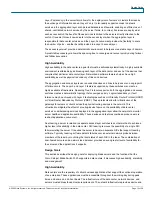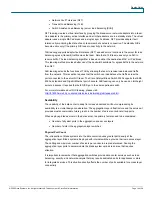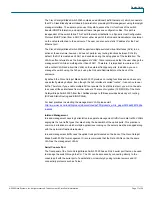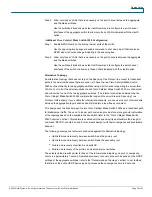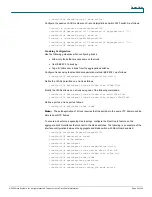
Design Guide
© 2008 Cisco Systems, Inc. All rights reserved. This document is Cisco Public Information.
Page 25 of 28
(config-if)# channel-group 1 mode active
Configure the passive LACP members on Cisco Catalyst Blade Switch 3020 switch A as follows:
(config) # interface GigabitEthernet0/19
(config-if)# description <<** Connected to Aggregation-1 **>>
(config-if)# channel-group 1 mode on
(config) # interface GigabitEthernet0/20
(config-if)# description <<** Connected to Aggregation-1 **>>
(config-if)# channel-group 1 mode on
Trunking Configuration
Use the following guidelines when configuring trunks:
●
Allow only those that are necessary on the trunk.
●
Use IEEE 802.1q trunking.
●
Tag all VLANs over a trunk from the aggregation switches.
Configure trunks using the standard encapsulation method IEEE 802.1q as follows:
(config-if)# switchport trunk encapsulation dot1q
Define the VLANs permitted on a trunk as follows:
(config-if)# switchport trunk allowed vlan <VLAN IDs>
Modify the VLANs allowed on a trunk using one of the following commands:
(config-if)# switchport trunk allowed vlan add <VLAN IDs>
(config-if)# switchport trunk allowed vlan remove <VLAN IDs>
Define a port as a trunk port as follows:
(config-if)# switchport mode trunk
Note:
The autonegotiation of a trunk requires that the ports be in the same VTP domain and be
able to pass DTP frames.
To secure and enforce a spanning-tree topology, configure the Root Guard feature on the
aggregate-switch interfaces that connect to the blade switches. The following is an example of the
interface configuration between the aggregate and blade switch with Root Guard enabled:
(config)# interface GigabitEthernet12/13
(config-if)# description <text>
(config-if)# no ip address
(config-if)# switchport
(config-if)# switchport trunk encapsulation dot1q
(config-if)# switchport trunk native vlan <vlan id>
(config-if)# switchport trunk allowed vlan <vlan id>
(config-if)# switchport mode trunk
(config-if)# spanning-tree guard root
(config-if)# channel-protocol lacp
(config-if)# channel-group <group id> mode active


